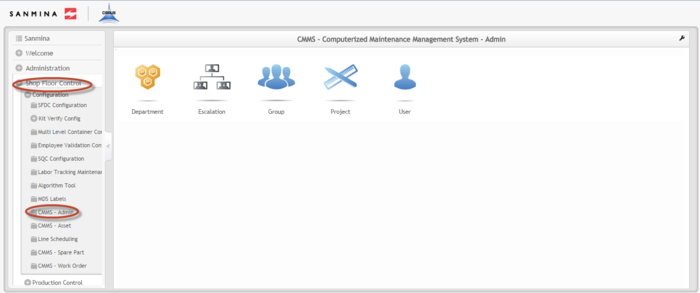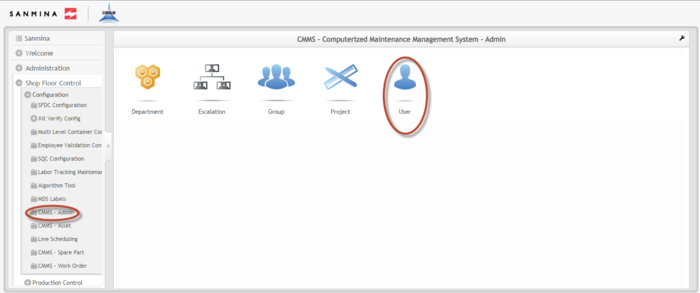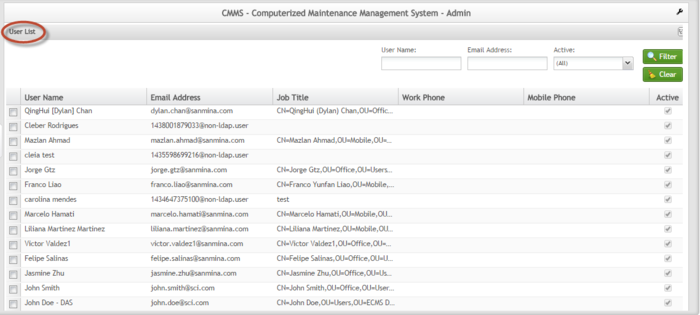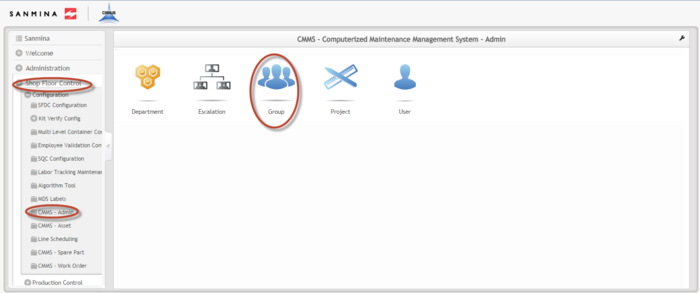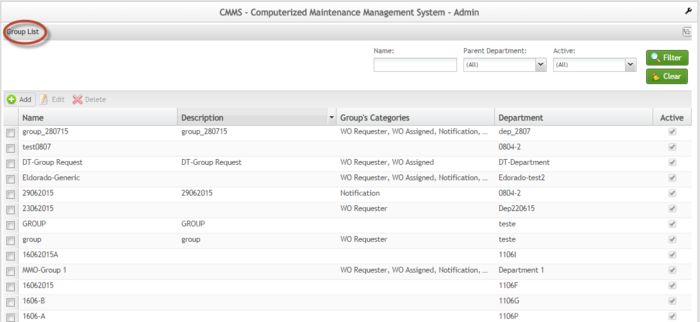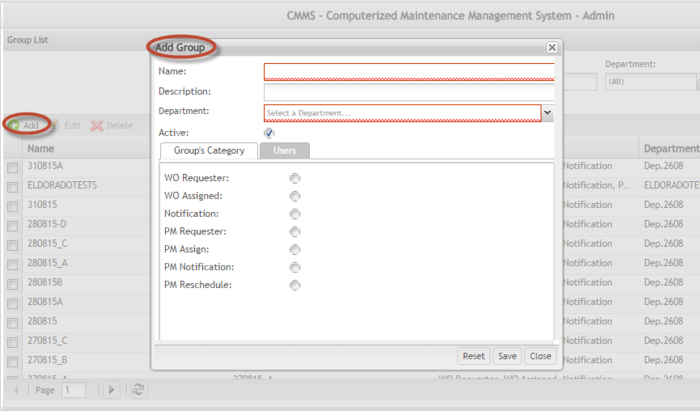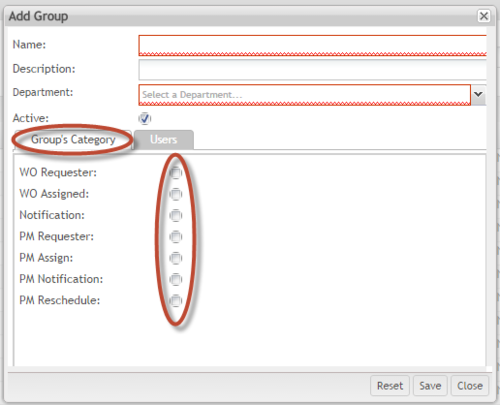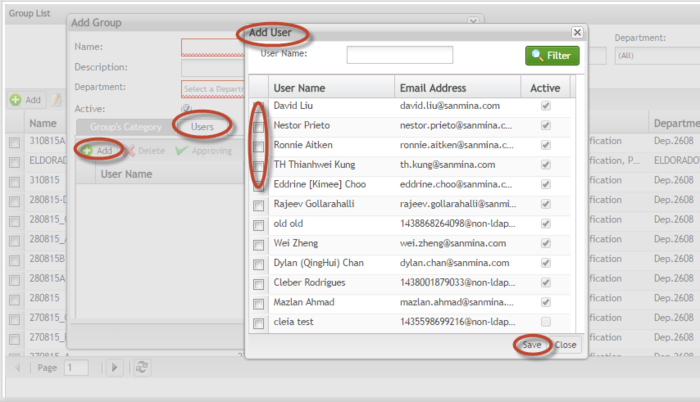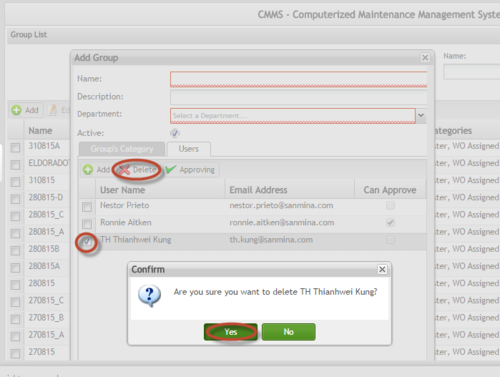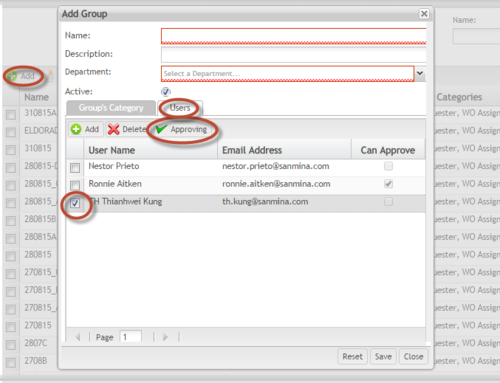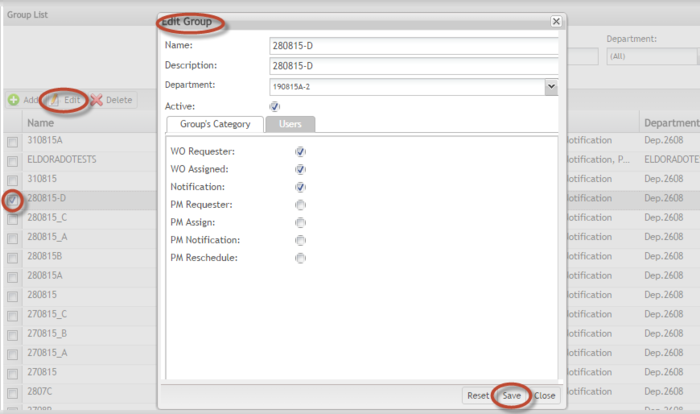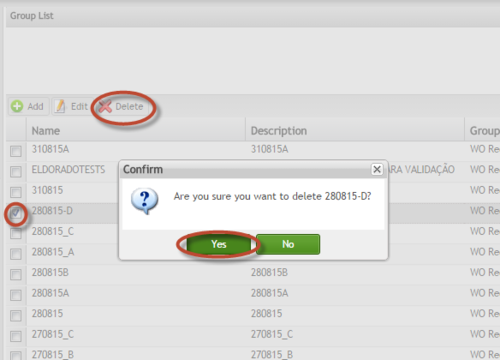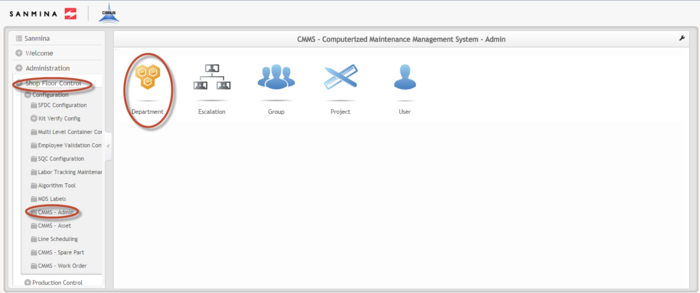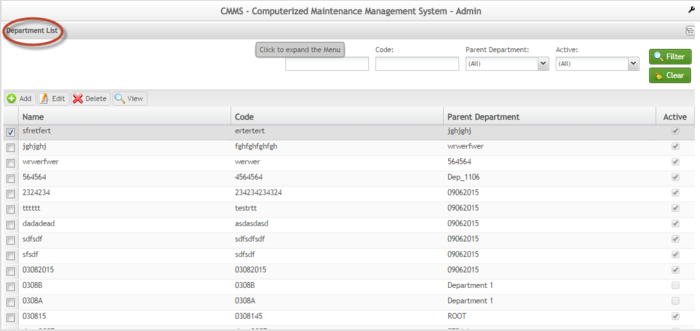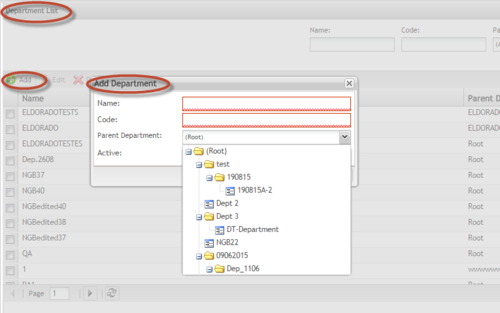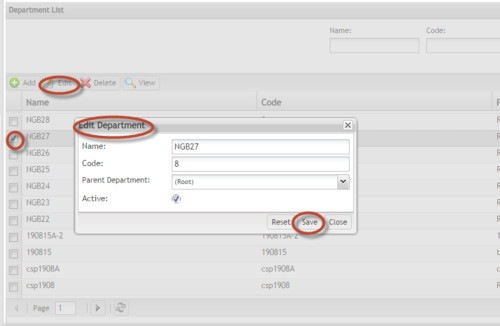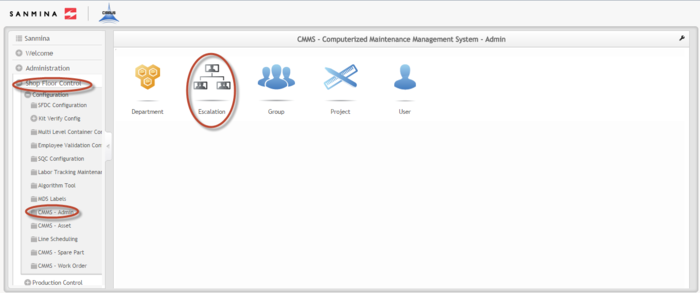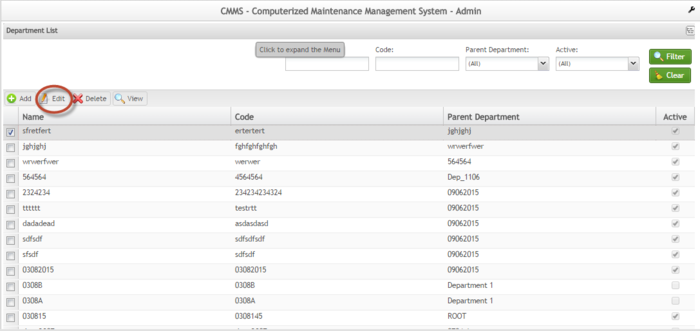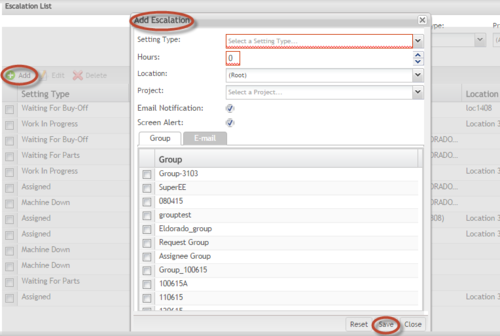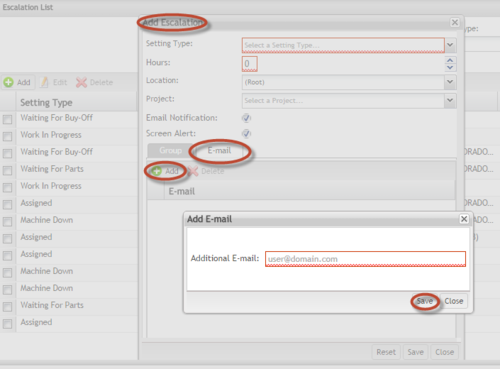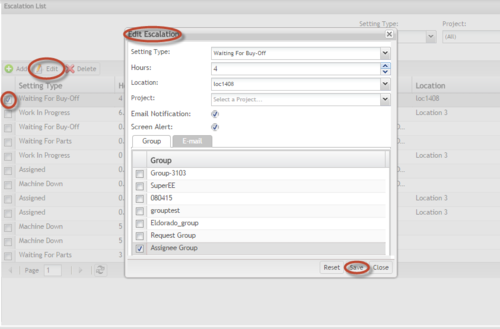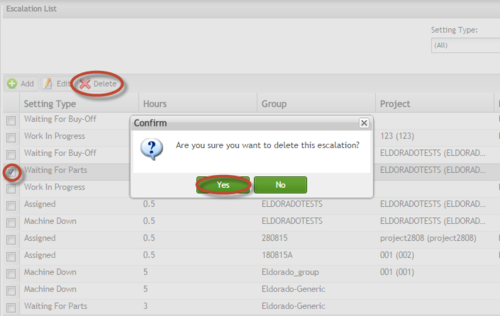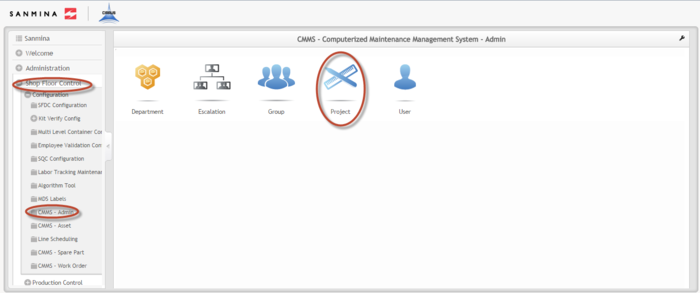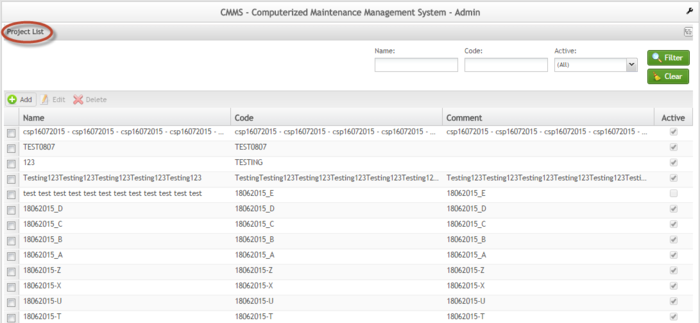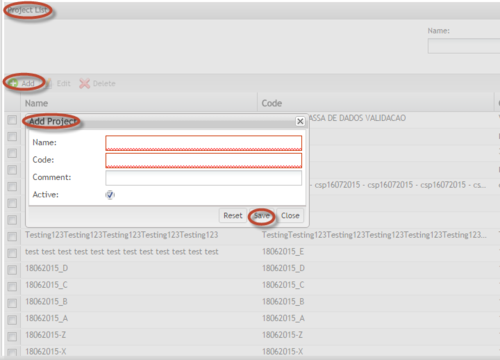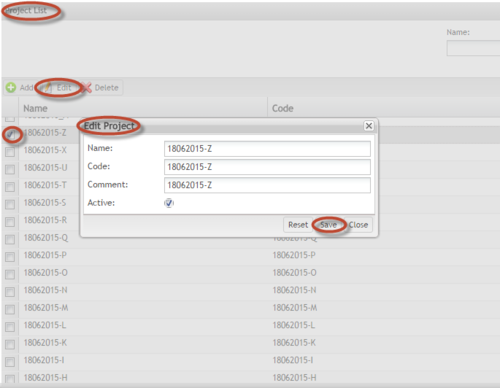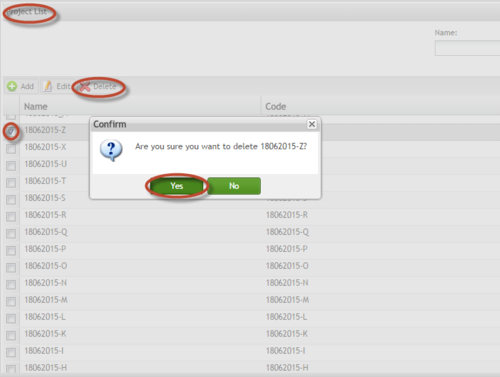Difference between revisions of "SOP-MES0073 CMMS Admin"
(Created page with "<small>Cirrus > Production > CMMS Administration</small><br> 130px|Sanmina logo.png <br> <center>'''CMMS Administration''...") |
|||
| Line 1: | Line 1: | ||
| − | <small>[[Cirrus]] | + | <small>[[Cirrus]] > [[Cirrus Production|Production]] > CMMS Administration</small><br> |
[[Image:Sanmina logo.png|130px|Sanmina logo.png]] | [[Image:Sanmina logo.png|130px|Sanmina logo.png]] | ||
| Line 9: | Line 9: | ||
''This edition applies to Cirrus and all subsequent releases and modifications until otherwise indicated in new revisions.'' | ''This edition applies to Cirrus and all subsequent releases and modifications until otherwise indicated in new revisions.'' | ||
| + | <br> | ||
| − | ==Administration== | + | == Administration == |
| − | |||
| − | + | ''This edition applies to CMMS for Cirrus and all subsequent releases and modifications until otherwise indicated in new revisions.'' | |
| − | + | The administration module is designed for administrators (Manufacturing Engineer profile) to perform all administration-related actions. There are six sub-modules available to local system administrators. Refer to the table below for sub-module names and corresponding functions: | |
| − | |||
| − | |||
| + | {| border="2" cellspacing="0" cellpadding="4" width="58%" | ||
| + | |- | ||
| + | | align="center" bgcolor="#CCCCCC" | '''Sub-module Name''' | ||
| + | | align="center" bgcolor="#CCCCCC" | '''Function''' | ||
|- | |- | ||
| − | |'''User'''<br> | + | | '''User'''<br> |
| − | | | + | | |
| − | * This module just displays the user list that comes from Portal and the admin user has not permission to change any data. | + | *This module just displays the user list that comes from Portal and the admin user has not permission to change any data. |
|- | |- | ||
| − | |'''Group<nowiki>’</nowiki>s Category'''<br> | + | | '''Group<nowiki>’</nowiki>s Category'''<br> |
| − | | | + | | |
| − | * Add a category | + | *Add a category |
| − | * Relate a category to a Purchase Request/Work Order/Work Request by defining its category type | + | *Relate a category to a Purchase Request/Work Order/Work Request by defining its category type |
| − | * Edit a category | + | *Edit a category |
| − | * Delete a category | + | *Delete a category |
|- | |- | ||
| − | |'''Group'''<br> | + | | '''Group'''<br> |
| − | | | + | | |
| − | * Add a group | + | *Add a group |
| − | * Assign categories to or remove categories from a group | + | *Assign categories to or remove categories from a group |
| − | * Add users to or remove users from a group | + | *Add users to or remove users from a group |
| − | * Edit a group | + | *Edit a group |
| − | * Enable/Disable a group | + | *Enable/Disable a group |
|- | |- | ||
| − | |align = "center"|'''Department''' | + | | align="center" | '''Department''' |
| − | | | + | | |
| − | * Add a department | + | *Add a department |
| − | * Edit a department | + | *Edit a department |
|- | |- | ||
| − | |align = "center"|'''Escalation ''' | + | | align="center" | '''Escalation ''' |
| − | | | + | | |
| − | * Add Setting Type | + | *Add Setting Type |
| − | * Edit Setting Type | + | *Edit Setting Type |
| − | * Delete Setting Type | + | *Delete Setting Type |
|- | |- | ||
| − | |align = "center"|'''Project''' | + | | align="center" | '''Project''' |
| − | | | + | | |
| − | * Add a code | + | *Add a code |
| − | * Edit a code | + | *Edit a code |
| − | * Enable/Disable a code | + | *Enable/Disable a code |
|} | |} | ||
| − | <u>NOTE</u>: See below the available profiles and their respective modules access. | + | <u>NOTE</u>: See below the available profiles and their respective modules access. |
| + | |||
| + | {| border="2" cellspacing="0" cellpadding="4" width="76%" | ||
| + | |- | ||
| + | | align="center" | <br>'''Equipment Operator''' | ||
| + | | align="center" | <br>'''Engineer (Quality, Process, Facility)''' | ||
| + | | align="center" | <br>'''Manufacturing Engineer''' | ||
| + | | align="center" | <br>'''Spare Part/Asset Management''' | ||
| + | |- | ||
| + | | CMMS Work Order | ||
| + | *Work Order<br> | ||
| + | |||
| + | | CMMS Work Order | ||
| + | *Work Order | ||
| − | + | | CMMS Admin | |
| − | + | *Department | |
| − | + | *Escalation | |
| − | + | *Group | |
| − | + | *Project | |
| + | *User<br>CMMS Asset | ||
| + | *Asset | ||
| + | *Checklist | ||
| + | *Location | ||
| + | *Machine Type | ||
| + | *Problem | ||
| + | *Problem Category | ||
| + | *Production Line | ||
| + | *Root Cause<br>CMMS Spare Part | ||
| + | *Company | ||
| + | *Part List<br>CMMS Work Order | ||
| + | *Calendar | ||
| + | *Preventative Maintenance | ||
| + | *Reschedule | ||
| + | *Work Order | ||
| − | + | | CMMS Asset | |
| − | + | *Asset | |
| − | + | *Checklist | |
| − | + | *Location | |
| − | + | *Machine Type | |
| − | + | *Problem | |
| − | + | *Problem Category | |
| − | + | *Production Line | |
| − | + | *Root Cause<br>CMMS Spare Part | |
| − | + | *Company | |
| − | + | *Part List<br>CMMS Work Order | |
| − | + | *Work Order<br> | |
| − | |||
| − | |||
| − | |||
| − | |||
| − | |||
| − | |||
| − | |||
| − | |||
| − | |||
| − | |||
| − | |||
| − | |||
| − | |||
| − | |CMMS Asset | ||
| − | * Asset | ||
| − | * Checklist | ||
| − | * Location | ||
| − | * Machine Type | ||
| − | * Problem | ||
| − | * Problem Category | ||
| − | * Production Line | ||
| − | * Root Cause<br>CMMS Spare Part | ||
| − | * Company | ||
| − | * Part List<br>CMMS Work Order | ||
| − | * Work Order<br> | ||
|} | |} | ||
| − | The CMMS Administration Module is accessed by select | + | The CMMS Administration Module is accessed by select '''Shop Floor Control''' <nowiki>></nowiki> '''Configuration''' <nowiki>></nowiki> '''CMMS-Admin''' |
| − | ''' Figure 1: CMMS Administration Module''' | + | '''Figure 1: CMMS Administration Module''' |
| − | [[Image: | + | [[Image:CMMS_Adm01.png|700px]]<br> |
| + | <br> Now the user is able to access all available CMMS Administration sub-modules. | ||
| − | |||
---- | ---- | ||
| − | |||
| − | |||
| − | 1. To access User sub-module, navigate to '''CMMS-Admin <nowiki>></nowiki> User'''. | + | === User === |
| + | |||
| + | The main purpose of this sub-module is import information from Liferay and allows users to view that information in order to assign for groups, escalation and WO. Only administrator users can access this feature. | ||
| + | |||
| + | 1. To access User sub-module, navigate to '''CMMS-Admin <nowiki>></nowiki> User'''. | ||
| + | |||
| + | '''Figure 2: User Administration''' | ||
| + | |||
| + | [[Image:CMMS_Adm02.png|700px]]<br> | ||
| − | ''' | + | 2. The '''User List''' displays all existing users. |
| − | + | '''Figure 3: User List''' | |
| − | + | [[Image:CMMS_Adm03.png|700px]]<br> | |
| − | ''' | + | The user can search by: '''Active'''/'''Inactive''', '''Email Address''' and '''User Name''' fields. It is not allowed to ADD, EDIT or DELETE an user from the list. |
| − | + | User data should be listed by: | |
| − | + | *'''Email address''': email address from the user register in the System (MES PORTAL); | |
| + | *'''User name''': First and last name from the user register in the System (MES PORTAL); | ||
| + | *'''Job Title''': title from the user register in the System (MES PORTAL); | ||
| + | *'''Work Phone''': phone from the user register in the System (MES PORTAL); | ||
| + | *'''Mobile Phone''': Mobile from the user register in the System (MES PORTAL); | ||
| + | *'''Active''': if user is disabled in the System, this information should be presented as unchecked. Otherwised | ||
| − | + | should be presented checked. | |
| − | |||
| − | |||
| − | |||
| − | |||
| − | |||
| − | |||
| − | |||
---- | ---- | ||
| − | |||
| − | |||
| − | 1. To access Group Maintenance, navigate to '''CMMS-Admin '''<nowiki>></nowiki> '''Group'''. | + | === Group === |
| + | |||
| + | This section covers how to perform group maintenance in the CMMS system. Group in CMMS means a group of users who handle the same group<nowiki>’</nowiki>s category or categories of problems, requests or tasks. Therefore when creating a group, the user must have a clear concept of what group<nowiki>’</nowiki>s categories will handle. The user must also be able to associate target categories to the group and must be able to add users into the group to follow. In Group Maintenance, administrators can add, edit or delete groups as well as assign categories and users to a specific group. | ||
| + | |||
| + | 1. To access Group Maintenance, navigate to '''CMMS-Admin '''<nowiki>></nowiki> '''Group'''. | ||
| + | |||
| + | '''Figure 4: Group Maintenance''' | ||
| + | |||
| + | [[Image:CMMS_Adm04.png|700px]]<br> | ||
| + | |||
| + | 2. The Group List displays all existing groups. | ||
| + | |||
| + | '''Figure 5: Group List''' | ||
| + | |||
| + | [[Image:CMMS_Adm05.png|700px]]<br> | ||
| + | |||
| + | ==== Add Group ==== | ||
| + | |||
| + | 1. To add a Group, select '''Add '''located above the '''Group List'''. | ||
| + | |||
| + | '''Figure 6: Add Group''' | ||
| − | + | [[Image:CMMS_Adm06.png|700px]]<br> | |
| − | + | 2. The '''Add Group '''form will display: | |
| − | + | 3. Enter the following information: | |
| − | ''' | + | *'''Name '''(Mandatory): The group name to be added to system. |
| + | *'''Department '''(Mandatory): Select a department from the drop down box provided. | ||
| + | *'''Active''': Allows the user to enable or disable a group. Default value is enabled. To disable a group, uncheck the checkbox. | ||
| + | *'''Description '''(Optional): Additional details of the group. | ||
| − | + | NOTE: It is not allowed groups with the same name in the system. | |
| − | + | 4. If the user doesn<nowiki>’</nowiki>t want assign a category to group or users, select '''Save '''to confirm or '''Close '''to exit, otherwise, fill out the information in the available tabs ('''Group<nowiki>’</nowiki>s Category''' and '''Users'''). | |
| − | |||
| − | + | ===== Assign Category to a Group ===== | |
| − | + | All existing categories will appear in the list under the '''Group<nowiki>’</nowiki>s Category '''tab. The administrator can assign a category to a group from this tab. | |
| − | + | 1. To assign a category to a group, place a check in the box to the left of the category name. | |
| − | + | 2. Select '''Save '''to confirm or '''Close '''to exit. | |
| − | + | '''Figure 7: Assign Category to Group''' | |
| − | |||
| − | |||
| − | |||
| − | |||
| − | + | [[Image:CMMS_Adm07.png|500px]]<br> | |
| − | + | <u>NOTE:</u> If there is not a proper category in the list, the user will need to create a category before. | |
| − | |||
| − | + | ===== Assign Users to a Group ===== | |
| − | + | The administrator can assign users to a group form the '''Users '''tab. | |
| − | ''' | + | 1. To assign a user to a group, select '''Add '''located above the '''User Name '''list. |
| − | + | 2. The '''Add User '''pop-up displays: | |
| − | + | '''Figure 8: Assign Users to Group''' | |
| − | + | [[Image:CMMS_Adm08.png|700px]]<br> | |
| − | |||
| − | + | 3. Place a check in the box to the left of the '''User Name '''to be assigned to the group. | |
| − | + | 4. Select '''Save '''to confirm or '''Close '''to exit. | |
| − | + | ===== ¬Delete Users from a Group ===== | |
| − | + | 1. To delete a user from a group, select the user from the '''User Name '''list and then select '''Delete'''. | |
| − | + | '''Figure 9: Delete User from Group''' | |
| − | + | [[Image:CMMS_Adm09.png|500px]]<br> | |
| − | + | 2. Select '''Yes '''to confirm or '''No '''to exit. | |
| − | + | ===== Approving Users from a Group ===== | |
| − | + | If the checkbox is marked, it indicates that the user is allowed to re-schedule in the Preventive Maintenance Module. | |
| − | + | '''Figure 10: Approving User''' | |
| − | + | [[Image:CMMS_Adm10.png|500px]]<br> | |
| − | ==== | + | ==== Edit Group ==== |
| − | + | 1. To edit an existing Group, select the group from the '''Group List''' and then select '''Edit'''. | |
| − | ''' | + | 2. The '''Edit''' '''Group '''pop-up displays: |
| − | + | '''Figure 11: Edit Group''' | |
| − | + | [[Image:CMMS_Adm11.png|700px]]<br> | |
| − | |||
| − | + | 3. The following items are available to update and the rules are the same as for '''Add Group''': | |
| − | ''' | + | *'''Name''', '''Description, Active Status '''and'''Department.''' |
| + | *Check or uncheck the '''Active''' checkbox to enable or disable the group. | ||
| + | *Assign or remove categories from the group in the '''Group<nowiki>’</nowiki>s''' '''Category '''tab. | ||
| + | *Add users to or delete users from the group in the '''Users '''tab. | ||
| − | + | 4. After updating, select '''Save '''to confirm. Select '''Close '''to exit without updating. | |
| − | + | ==== Delete Group ==== | |
| − | + | 1. To delete an existing Group, select the group from the '''Group Name '''list and then select '''Delete'''. | |
| − | |||
| − | |||
| − | |||
| − | |||
| − | + | '''Figure 12: Delete Group''' | |
| − | |||
| − | + | [[Image:CMMS_Adm12.png|500px]]<br> | |
| − | + | 2. The confirmation message displays: | |
| − | + | 3. Select '''Yes '''from the confirmation prompt to confirm, or '''No '''to exit. | |
| − | + | NOTE: If the group is be used, it is not be allowed to delete the group. | |
| − | |||
---- | ---- | ||
| − | |||
| − | This section covers how to perform department maintenance in the CMMS system. In Department Maintenance, administrators can add, edit, delete and view departments hierarchies. | + | === Department Maintenance === |
| + | |||
| + | This section covers how to perform department maintenance in the CMMS system. In Department Maintenance, administrators can add, edit, delete and view departments hierarchies. | ||
| + | |||
| + | 1. To access Department Maintenance, navigate to '''CMMS-Admin <nowiki>></nowiki> Department'''. | ||
| + | |||
| + | '''Figure 13: Department Maintenance''' | ||
| − | + | [[Image:CMMS_Adm13.png|700px]]<br> | |
| − | ''' | + | 2. A '''Department '''list displays with all added departments. |
| − | + | '''Figure 14: Department Name List''' | |
| − | + | [[Image:CMMS_Adm14.png|700px]]<br> | |
| − | + | ==== Add Department ==== | |
| − | + | 1. To add a department, select '''Add '''located above the '''Department''' list. A pop-up displays with the '''Add '''functions. | |
| − | + | 2. The '''Add Department '''pop up displays: | |
| − | + | '''Figure 15: Add Department''' | |
| − | + | [[Image:CMMS_Adm15.png|500px]]<br> | |
| − | ''' | + | 3. Enter the '''Department Name '''and the '''Department Code''' (mandatory). The department will be added as a child if the user doesen<nowiki>’</nowiki>t choose the parent department in the '''Parent Department''' node. |
| − | + | 4. Select '''Save '''to confirm. | |
| − | + | NOTE:The maximum level of the tree is six. A warning message is displayed. | |
| − | + | ==== Edit Department ==== | |
| − | + | 1. To edit a department, choose the department and select '''Edit'''. A pop-up displays with the '''Edit '''function. | |
| − | + | 2. The '''Edit Department '''form displays: | |
| − | + | The '''ROOT''' node could be changed. | |
| − | + | <u>NOTE</u>:''''' ''''' If the user disables a department, all of the children departments associated with it eill be automatically disable. | |
| − | + | '''Figure 16: Edit Department''' | |
| − | < | + | [[Image:CMMS_Adm16.png|500px]]<br> |
| − | + | 3. The following items are available to update: | |
| − | + | *'''Name ('''Mandatory): Enter the department name to update. | |
| + | *'''Code '''(Mandatory): Enter the department code to update. | ||
| + | *'''Enable '''(Mandatory): Toggle the check box to change the active status. If the user disables one department, all of the children departments associated with it will automatically disable. | ||
| + | *'''Parent Department''': Displays all available departments in the local system. Select the parent department name that will be the new parent department of the item to be updated. | ||
| − | + | 4. After updating, select '''Save '''to confirm. | |
| − | + | 5. Select '''Close '''to exit. | |
| − | |||
| − | |||
| − | |||
| − | |||
| − | |||
---- | ---- | ||
| − | |||
| − | |||
| − | 1. To access '''Escalation Setting''', navigate to '''Administration <nowiki>></nowiki> Escalation Setting.''' | + | === Escalation Maintenance === |
| + | |||
| + | This section covers how perform escalation setting maintenance. Whenever an asset fails or a work order has been in a certain status for too long, higher levels of authority need to be notified to expedite maintenance. If maintenance fails to respond, higher levels of authority need to be notified. Escalation setting allows the administrator to create, edit or delete escalation settings. | ||
| + | |||
| + | 1. To access '''Escalation Setting''', navigate to '''Administration <nowiki>></nowiki> Escalation Setting.''' | ||
| + | |||
| + | '''Figure 17: Escalation Setting''' | ||
| − | + | [[Image:CMMS_Adm17.png|700px]]<br> | |
| − | + | 2. The Escalation List displays all existing setting types. | |
| − | + | '''Figure 18: Escalation List''' | |
| − | + | [[Image:CMMS_Adm18.png|700px]]<br> | |
| − | + | ==== Add Escalation ==== | |
| − | + | 1. To add an escalation, select '''Add '''located above the '''Setting Type '''list. | |
| − | + | 2. The '''Add '''pop up displays: | |
| − | + | '''Figure 19: Add Escalation''' | |
| − | + | [[Image:CMMS_Adm19.png|500px]]<br> | |
| − | + | 3. To add an escalation, enter the following information: | |
| − | + | *'''Setting Type'''- Select a setting type from the following: | |
| − | * ''' | + | *'''Machine Down''': if the corresponding asset has broken down for more than the specified time (defined in the "Hours" field below), send an email or alert the specific group (defined in "Group" tab below). |
| + | *'''Assigned''': if the specific work order has been in "Assigned" status for more than the specified time, send an email or alert the specific group. | ||
| + | *'''Work in Progress''': if the specific work order has been in status "Work in Progress" for more than the specified time, send an email or alert the specific group. | ||
| + | *'''Waiting for Parts''': if the specific work order has been in status "Waiting For Parts" for more than the specified time, send an email or alert the specific group. | ||
| + | *'''Waiting for Buy-off''': if the specific work order has been in status "Waiting For Buy-off" for more than the specified time, send an email or alert the specific group. | ||
| + | *'''Hours'''- Enter the amount of time maintenance has to change the status of the work order (time in hours). | ||
| + | *'''Project'''- Select the Project Code associated with the escalation setting from the drop down list provided. This field is optional. However, if null, the escalation setting will be a default escalation setting. This means every work order, with or without a project code, has to send emails and/or alerts according to this setting. If given a code, this escalation setting is operated only by work orders with the same project code. | ||
| + | *'''Email Notification'''- The default is selected. If the user does not want an email notification, remove the checkmark from the box provided. | ||
| + | *'''Screen Alert'''- The default is selected. If the user does not want a screen alert, remove the checkmark from the box provided. The alert information appears on the dashboard. If selected, this escalation setting will send alerts on the dashboard once the setting condition is satisfied. If not, no alert will be sent. | ||
| + | *'''Group Tab'''- Select the group associated with the escalation setting. It is possible choose more than one group. This will be the receiver of the e-mails or alerts. | ||
| + | *'''E-mail tab'''- Add or delete e-mails different from those inside the company. It is possible to add more than one e-mail and the email can be the same e-mails inserted for the escalation. | ||
| − | + | '''Figure 20: Additional E-mail''' | |
| − | |||
| − | |||
| − | |||
| − | |||
| − | |||
| − | |||
| − | |||
| − | |||
| − | |||
| − | |||
| − | + | [[Image:CMMS_Adm20.png|500px]]<br> | |
| − | ''' | + | 4. Select '''Save '''to add the escalation setting. Select '''Close '''to exit without saving. |
| − | |||
| − | ''' | ||
| − | + | '''NOTE''': it is not allowed other escalation with the same setting type and a project in the system. | |
| − | + | ==== Edit Escalation ==== | |
| − | + | 1. To edit an escalation, select the setting type from the list and then select '''Edit'''. | |
| − | + | 2. The '''Edit '''pop up displays: | |
| − | + | '''Figure 21: Edit Escalation''' | |
| − | + | [[Image:CMMS_Adm21.png|500px]]<br> | |
| − | + | 3. All fields are available to update. After updating, select '''Save '''to confirm or '''Close '''to exit without saving. | |
| − | + | ==== Delete Escalation ==== | |
| − | + | 1. To delete and escalation setting, select the setting type from the list and then select '''Delete'''. | |
| − | + | 2. A confirmation pop-up will display: | |
| − | + | '''Figure 22: Delete Escalation Setting''' | |
| − | + | [[Image:CMMS_Adm22.png|500px]]<br> | |
| − | + | 3. Select '''Yes '''to confirm or '''No '''to cancel. | |
| − | |||
---- | ---- | ||
| − | |||
| − | This section covers Project Maintenance. This section provides add, edit and delete functions for project codes used in the Escalation section. | + | === Project === |
| + | |||
| + | This section covers Project Maintenance. This section provides add, edit and delete functions for project codes used in the Escalation section. | ||
| + | |||
| + | 1. To access Project Maintenance, navigate to '''CMMS- admin <nowiki>></nowiki> Project'''. | ||
| + | |||
| + | '''Figure 23: Project Maintenance''' | ||
| − | + | [[Image:CMMS_Adm23.png|700px]]<br> | |
| − | + | 2. The Project list displays all existing projects. | |
| − | + | '''Figure 24: Project List''' | |
| − | + | [[Image:CMMS_Adm24.png|700px]]<br> | |
| − | + | ==== Add Project ==== | |
| − | + | 1. To add a project, select '''Add''' located above the '''Name''' list. | |
| − | + | 2. The '''Add '''pop up displays: | |
| − | |||
| − | + | '''Figure 25: Add Project''' | |
| − | + | [[Image:CMMS_Adm25.png|500px]]<br> | |
| − | + | 3. To add a Project, enter the following information: | |
| − | + | *'''Code- '''an acronym that facilitates the identification of the plant. | |
| + | *'''Name-''' the name of the project. | ||
| + | *'''Active- '''The default is selected. If the user wants to deactivate the project, remove the check mark from the box provided. | ||
| + | *'''Comment'''- any additional information needed for the project. | ||
| − | + | 4. After entering all necessary information, select '''Save''' to confirm addition. The new project will appear in the Project list on the main Project screen. | |
| − | |||
| − | |||
| − | |||
| − | + | 5. Select '''Close '''to exit without saving. | |
| − | + | ==== Edit Project ==== | |
| − | + | 1. To edit a project, select the project from the list and then select '''Edit'''. | |
| − | 1. To edit a project, select the project from the list and then select '''Edit'''. | ||
| − | 2. The '''Edit '''pop up displays: | + | 2. The '''Edit '''pop up displays: |
| − | '''Figure 26: Edit Project''' | + | '''Figure 26: Edit Project''' |
| − | [[Image: | + | [[Image:CMMS_Adm26.png|500px]]<br> |
| − | 3. All fields are available to update. After updating, select '''Save '''to confirm or '''Close '''to exit without saving. | + | 3. All fields are available to update. After updating, select '''Save '''to confirm or '''Close '''to exit without saving. |
| − | ====Delete Project==== | + | ==== Delete Project ==== |
| − | |||
| − | + | 1. To delete a project, select the project from the list and then select '''Delete'''. | |
| − | + | 2. A confirmation message is displayed: | |
| − | + | '''Figure 27: Delete Project''' | |
| − | + | [[Image:CMMS_Adm27.png|500px]]<br> | |
| − | + | 3. Select '''Yes '''to confirm or '''No '''to cancel. | |
| − | + | NOTE: The system verifies if project is being used in another table. If so, it is not possible to delete and a warning message is displayed. | |
| − | + | == Document Revision History == | |
| − | |||
| − | |||
| − | |||
| − | |||
| − | |||
| + | {| border="2" cellspacing="0" cellpadding="4" width="100%" | ||
| + | |- | ||
| + | | align="center" bgcolor="#00FFFF" | <font color="#FFFFFF">Date</font> | ||
| + | | align="center" bgcolor="#00FFFF" | <font color="#FFFFFF">Author</font> | ||
| + | | align="center" bgcolor="#00FFFF" | <font color="#FFFFFF">Title</font> | ||
| + | | align="center" bgcolor="#00FFFF" | <font color="#FFFFFF">Version</font> | ||
| + | | align="center" bgcolor="#00FFFF" | <font color="#FFFFFF">Change Reference</font> | ||
|- | |- | ||
| − | |09/01/15 | + | | 09/01/15 |
| − | |Elaine Fonaro | + | | Elaine Fonaro |
| − | |Technical Writer | + | | Technical Writer |
| − | |v 1.0 | + | | v 1.0 |
| − | |This is the first revision of CMMS Administration for Cirrus | + | | This is the first revision of CMMS Administration for Cirrus |
| − | |||
|} | |} | ||
| − | [[ | + | [[Category:Uncategorized]] |
Revision as of 21:55, 8 December 2015
Cirrus > Production > CMMS Administration
This edition applies to Cirrus and all subsequent releases and modifications until otherwise indicated in new revisions.
Contents
Administration
This edition applies to CMMS for Cirrus and all subsequent releases and modifications until otherwise indicated in new revisions.
The administration module is designed for administrators (Manufacturing Engineer profile) to perform all administration-related actions. There are six sub-modules available to local system administrators. Refer to the table below for sub-module names and corresponding functions:
| Sub-module Name | Function |
| User |
|
| Group’s Category |
|
| Group |
|
| Department |
|
| Escalation |
|
| Project |
|
NOTE: See below the available profiles and their respective modules access.
Equipment Operator |
Engineer (Quality, Process, Facility) |
Manufacturing Engineer |
Spare Part/Asset Management |
CMMS Work Order
|
CMMS Work Order
|
CMMS Admin
|
CMMS Asset
|
The CMMS Administration Module is accessed by select Shop Floor Control > Configuration > CMMS-Admin
Figure 1: CMMS Administration Module
Now the user is able to access all available CMMS Administration sub-modules.
User
The main purpose of this sub-module is import information from Liferay and allows users to view that information in order to assign for groups, escalation and WO. Only administrator users can access this feature.
1. To access User sub-module, navigate to CMMS-Admin > User.
Figure 2: User Administration
2. The User List displays all existing users.
Figure 3: User List
The user can search by: Active/Inactive, Email Address and User Name fields. It is not allowed to ADD, EDIT or DELETE an user from the list.
User data should be listed by:
- Email address: email address from the user register in the System (MES PORTAL);
- User name: First and last name from the user register in the System (MES PORTAL);
- Job Title: title from the user register in the System (MES PORTAL);
- Work Phone: phone from the user register in the System (MES PORTAL);
- Mobile Phone: Mobile from the user register in the System (MES PORTAL);
- Active: if user is disabled in the System, this information should be presented as unchecked. Otherwised
should be presented checked.
Group
This section covers how to perform group maintenance in the CMMS system. Group in CMMS means a group of users who handle the same group’s category or categories of problems, requests or tasks. Therefore when creating a group, the user must have a clear concept of what group’s categories will handle. The user must also be able to associate target categories to the group and must be able to add users into the group to follow. In Group Maintenance, administrators can add, edit or delete groups as well as assign categories and users to a specific group.
1. To access Group Maintenance, navigate to CMMS-Admin > Group.
Figure 4: Group Maintenance
2. The Group List displays all existing groups.
Figure 5: Group List
Add Group
1. To add a Group, select Add located above the Group List.
Figure 6: Add Group
2. The Add Group form will display:
3. Enter the following information:
- Name (Mandatory): The group name to be added to system.
- Department (Mandatory): Select a department from the drop down box provided.
- Active: Allows the user to enable or disable a group. Default value is enabled. To disable a group, uncheck the checkbox.
- Description (Optional): Additional details of the group.
NOTE: It is not allowed groups with the same name in the system.
4. If the user doesn’t want assign a category to group or users, select Save to confirm or Close to exit, otherwise, fill out the information in the available tabs (Group’s Category and Users).
Assign Category to a Group
All existing categories will appear in the list under the Group’s Category tab. The administrator can assign a category to a group from this tab.
1. To assign a category to a group, place a check in the box to the left of the category name.
2. Select Save to confirm or Close to exit.
Figure 7: Assign Category to Group
NOTE: If there is not a proper category in the list, the user will need to create a category before.
Assign Users to a Group
The administrator can assign users to a group form the Users tab.
1. To assign a user to a group, select Add located above the User Name list.
2. The Add User pop-up displays:
Figure 8: Assign Users to Group
3. Place a check in the box to the left of the User Name to be assigned to the group.
4. Select Save to confirm or Close to exit.
¬Delete Users from a Group
1. To delete a user from a group, select the user from the User Name list and then select Delete.
Figure 9: Delete User from Group
2. Select Yes to confirm or No to exit.
Approving Users from a Group
If the checkbox is marked, it indicates that the user is allowed to re-schedule in the Preventive Maintenance Module.
Figure 10: Approving User
Edit Group
1. To edit an existing Group, select the group from the Group List and then select Edit.
2. The Edit Group pop-up displays:
Figure 11: Edit Group
3. The following items are available to update and the rules are the same as for Add Group:
- Name, Description, Active Status andDepartment.
- Check or uncheck the Active checkbox to enable or disable the group.
- Assign or remove categories from the group in the Group’s Category tab.
- Add users to or delete users from the group in the Users tab.
4. After updating, select Save to confirm. Select Close to exit without updating.
Delete Group
1. To delete an existing Group, select the group from the Group Name list and then select Delete.
Figure 12: Delete Group
2. The confirmation message displays:
3. Select Yes from the confirmation prompt to confirm, or No to exit.
NOTE: If the group is be used, it is not be allowed to delete the group.
Department Maintenance
This section covers how to perform department maintenance in the CMMS system. In Department Maintenance, administrators can add, edit, delete and view departments hierarchies.
1. To access Department Maintenance, navigate to CMMS-Admin > Department.
Figure 13: Department Maintenance
2. A Department list displays with all added departments.
Figure 14: Department Name List
Add Department
1. To add a department, select Add located above the Department list. A pop-up displays with the Add functions.
2. The Add Department pop up displays:
Figure 15: Add Department
3. Enter the Department Name and the Department Code (mandatory). The department will be added as a child if the user doesen’t choose the parent department in the Parent Department node.
4. Select Save to confirm.
NOTE:The maximum level of the tree is six. A warning message is displayed.
Edit Department
1. To edit a department, choose the department and select Edit. A pop-up displays with the Edit function.
2. The Edit Department form displays:
The ROOT node could be changed.
NOTE: If the user disables a department, all of the children departments associated with it eill be automatically disable.
Figure 16: Edit Department
3. The following items are available to update:
- Name (Mandatory): Enter the department name to update.
- Code (Mandatory): Enter the department code to update.
- Enable (Mandatory): Toggle the check box to change the active status. If the user disables one department, all of the children departments associated with it will automatically disable.
- Parent Department: Displays all available departments in the local system. Select the parent department name that will be the new parent department of the item to be updated.
4. After updating, select Save to confirm.
5. Select Close to exit.
Escalation Maintenance
This section covers how perform escalation setting maintenance. Whenever an asset fails or a work order has been in a certain status for too long, higher levels of authority need to be notified to expedite maintenance. If maintenance fails to respond, higher levels of authority need to be notified. Escalation setting allows the administrator to create, edit or delete escalation settings.
1. To access Escalation Setting, navigate to Administration > Escalation Setting.
Figure 17: Escalation Setting
2. The Escalation List displays all existing setting types.
Figure 18: Escalation List
Add Escalation
1. To add an escalation, select Add located above the Setting Type list.
2. The Add pop up displays:
Figure 19: Add Escalation
3. To add an escalation, enter the following information:
- Setting Type- Select a setting type from the following:
- Machine Down: if the corresponding asset has broken down for more than the specified time (defined in the "Hours" field below), send an email or alert the specific group (defined in "Group" tab below).
- Assigned: if the specific work order has been in "Assigned" status for more than the specified time, send an email or alert the specific group.
- Work in Progress: if the specific work order has been in status "Work in Progress" for more than the specified time, send an email or alert the specific group.
- Waiting for Parts: if the specific work order has been in status "Waiting For Parts" for more than the specified time, send an email or alert the specific group.
- Waiting for Buy-off: if the specific work order has been in status "Waiting For Buy-off" for more than the specified time, send an email or alert the specific group.
- Hours- Enter the amount of time maintenance has to change the status of the work order (time in hours).
- Project- Select the Project Code associated with the escalation setting from the drop down list provided. This field is optional. However, if null, the escalation setting will be a default escalation setting. This means every work order, with or without a project code, has to send emails and/or alerts according to this setting. If given a code, this escalation setting is operated only by work orders with the same project code.
- Email Notification- The default is selected. If the user does not want an email notification, remove the checkmark from the box provided.
- Screen Alert- The default is selected. If the user does not want a screen alert, remove the checkmark from the box provided. The alert information appears on the dashboard. If selected, this escalation setting will send alerts on the dashboard once the setting condition is satisfied. If not, no alert will be sent.
- Group Tab- Select the group associated with the escalation setting. It is possible choose more than one group. This will be the receiver of the e-mails or alerts.
- E-mail tab- Add or delete e-mails different from those inside the company. It is possible to add more than one e-mail and the email can be the same e-mails inserted for the escalation.
Figure 20: Additional E-mail
4. Select Save to add the escalation setting. Select Close to exit without saving.
NOTE: it is not allowed other escalation with the same setting type and a project in the system.
Edit Escalation
1. To edit an escalation, select the setting type from the list and then select Edit.
2. The Edit pop up displays:
Figure 21: Edit Escalation
3. All fields are available to update. After updating, select Save to confirm or Close to exit without saving.
Delete Escalation
1. To delete and escalation setting, select the setting type from the list and then select Delete.
2. A confirmation pop-up will display:
Figure 22: Delete Escalation Setting
3. Select Yes to confirm or No to cancel.
Project
This section covers Project Maintenance. This section provides add, edit and delete functions for project codes used in the Escalation section.
1. To access Project Maintenance, navigate to CMMS- admin > Project.
Figure 23: Project Maintenance
2. The Project list displays all existing projects.
Figure 24: Project List
Add Project
1. To add a project, select Add located above the Name list.
2. The Add pop up displays:
Figure 25: Add Project
3. To add a Project, enter the following information:
- Code- an acronym that facilitates the identification of the plant.
- Name- the name of the project.
- Active- The default is selected. If the user wants to deactivate the project, remove the check mark from the box provided.
- Comment- any additional information needed for the project.
4. After entering all necessary information, select Save to confirm addition. The new project will appear in the Project list on the main Project screen.
5. Select Close to exit without saving.
Edit Project
1. To edit a project, select the project from the list and then select Edit.
2. The Edit pop up displays:
Figure 26: Edit Project
3. All fields are available to update. After updating, select Save to confirm or Close to exit without saving.
Delete Project
1. To delete a project, select the project from the list and then select Delete.
2. A confirmation message is displayed:
Figure 27: Delete Project
3. Select Yes to confirm or No to cancel.
NOTE: The system verifies if project is being used in another table. If so, it is not possible to delete and a warning message is displayed.
Document Revision History
| Date | Author | Title | Version | Change Reference |
| 09/01/15 | Elaine Fonaro | Technical Writer | v 1.0 | This is the first revision of CMMS Administration for Cirrus |

